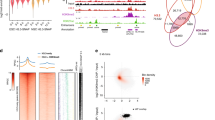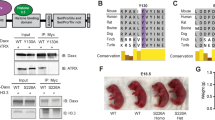Abstract
Suppressed expression of transgenes in vivo is the major obstacle in the gene therapy. For the long-term expression, we utilized a chromatin insulator from sea urchin arylsulfatase (Ars) gene locus (Ars insulator, ArsI), which has been shown to epigenetically regulate gene expression across species. ArsI was able to prevent silencing of the transgene in a myeloid cell line, HL-60, and a murine embryonic stem cell line, CCE, in an orientation-dependent manner, but not in Huh-7, K562 and MCF-7 cells, indicating that the effect of ArsI on gene silencing was cell type dependent. Although anti-silencing effect of ArsI was almost equivalent to that of chicken β-globin insulator, incorporation of ArsI into lentiviral vector had little effect on the virus titer compared with chicken β-globin insulator. Clonal analysis of transduced HL-60 cells revealed that ArsI protects the lentiviral vector from position effects regardless of its orientation. Furthermore, chromatin immunoprecipitation assays revealed that a high acetylation level was observed in the promoter of the insulated vector, whereas that of ArsI was independent of its anti-silencing capacity. In addition to it having little deteriorative effect on the virus titer, the identified anti-silencing effect of ArsI suggested its possibility for application in gene therapy.
This is a preview of subscription content, access via your institution
Access options
Subscribe to this journal
Receive 12 print issues and online access
$259.00 per year
only $21.58 per issue
Buy this article
- Purchase on Springer Link
- Instant access to full article PDF
Prices may be subject to local taxes which are calculated during checkout








Similar content being viewed by others
References
Verma IM, Somia N . Gene therapy – promises, problems and prospects. Nature 1997; 389: 239–242.
Pikaart MJ, Recillas-Targa F, Felsenfeld G . Loss of transcriptional activity of a transgene is accompanied by DNA methylation and histone deacetylation and is prevented by insulators. Genes Dev 1998; 12: 2852–2862.
Chen S, Corces VG . The gypsy insulator of Drosophila affects chromatin structure in a directional manner. Genetics 2001; 159: 1649–1658.
Bestor TH . Gene silencing as a threat to the success of gene therapy. J Clin Invest 2000; 105: 409–411.
Pannell D, Ellis J . Silencing of gene expression: implications for design of retrovirus vectors. Rev Med Virol 2001; 11: 205–217.
Pannell D et al. Retrovirus vector silencing is de novo methylase independent and marked by a repressive histone code. EMBO J 2000; 19: 5884–5894.
Naldini L et al. In vivo gene delivery and stable transduction of nondividing cells by a lentiviral vector. Science 1996; 272: 263–267.
Pfeifer A, Ikawa M, Dayn Y, Verma IM . Transgenesis by lentiviral vectors: lack of gene silencing in mammalian embryonic stem cells and preimplantation embryos. Proc Natl Acad Sci USA 2002; 99: 2140–2145.
Indraccolo S et al. Gene transfer in ovarian cancer cells: a comparison between retroviral and lentiviral vectors. Cancer Res 2002; 62: 6099–6107.
Chung JH, Whiteley M, Felsenfeld G . A 5′ element of the chicken beta-globin domain serves as an insulator in human erythroid cells and protects against position effect in Drosophila. Cell 1993; 74: 505–514.
Scott KC, Taubman AD, Geyer PK . Enhancer blocking by the Drosophila gypsy insulator depends upon insulator anatomy and enhancer strength. Genetics 1999; 153: 787–798.
Hark AT et al. CTCF mediates methylation-sensitive enhancer-blocking activity at the H19/Igf2 locus. Nature 2000; 405: 486–489.
Antes TJ, Namciu SJ, Fournier RE, Levy-Wilson B . The 5′ boundary of the human apolipoprotein B chromatin domain in intestinal cells. Biochemistry 2001; 40: 6731–6742.
West AG, Gaszner M, Felsenfeld G . Insulators: many functions, many mechanisms. Genes Dev 2002; 16: 271–288.
Chung JH, Bell AC, Felsenfeld G . Characterization of the chicken beta-globin insulator. Proc Natl Acad Sci USA 1997; 94: 575–580.
Litt MD et al. Correlation between histone lysine methylation and developmental changes at the chicken beta-globin locus. Science 2001; 293: 2453–2455.
Litt MD et al. Transitions in histone acetylation reveal boundaries of three separately regulated neighboring loci. EMBO J 2001; 20: 2224–2235.
Recillas-Targa F et al. Position-effect protection and enhancer blocking by the chicken beta-globin insulator are separable activities. Proc Natl Acad Sci USA 2002; 99: 6883–6888.
Mutskov VJ et al. The barrier function of an insulator couples high histone acetylation levels with specific protection of promoter DNA from methylation. Genes Dev 2002; 16: 1540–1554.
Emery DW, Yannaki E, Tubb J, Stamatoyannopoulos G . A chromatin insulator protects retrovirus vectors from chromosomal position effects. Proc Natl Acad Sci USA 2000; 97: 9150–9155.
Rivella S et al. The cHS4 insulator increases the probability of retroviral expression at random chromosomal integration sites. J Virol 2000; 74: 4679–4687.
Akasaka K et al. Upstream element of the sea urchin arylsulfatase gene serves as an insulator. Cell Mol Biol (Noisy-le-grand) 1999; 45: 555–565.
Nagaya S et al. An insulator element from the sea urchin Hemicentrotus pulcherrimus suppresses variation in transgene expression in cultured tobacco cells. Mol Genet Genom 2001; 265: 405–413.
Takada T et al. Evaluation of heterologous insulator function with regard to chromosomal position effect in the mouse blastocyst and fetus. Mol Reprod Dev 2000; 57: 232–237.
Rivella S, Sadelain M . Genetic treatment of severe hemoglobinopathies: the combat against transgene variegation and transgene silencing. Semin Hematol 1998; 35: 112–125.
Hamaguchi I et al. Lentivirus vector gene expression during ES cell-derived hematopoietic development in vitro. J Virol 2000; 74: 10778–10784.
Jenuwein T, Allis CD . Translating the histone code. Science 2001; 293: 1074–1080.
Curradi M, Izzo A, Badaracco G, Landsberger N . Molecular mechanisms of gene silencing mediated by dna methylation. Mol Cell Biol 2002; 22: 3157–3173.
Lever AM . Lentiviral vectors: progress and potential. Curr Opin Mol Ther 2000; 2: 488–496.
Dang Q, Auten J, Plavec I . Human beta interferon scaffold attachment region inhibits de novo methylation and confers long-term, copy number-dependent expression to a retroviral vector. J Virol 2000; 74: 2671–2678.
Murray L et al. Addition of the human interferon beta scaffold attachment region to retroviral vector backbones increases the level of in vivo transgene expression among progeny of engrafted human hematopoietic stem cells. Hum Gene Ther 2000; 11: 2039–2050.
Kowolik CM, Hu J, Yee JK . Locus control region of the human CD2 gene in a lentivirus vector confers position-independent transgene expression. J Virol 2001; 75: 4641–4648.
May C et al. Therapeutic haemoglobin synthesis in beta-thalassaemic mice expressing lentivirus-encoded human beta-globin. Nature 2000; 406: 82–86.
Cai S, Han HJ, Kohwi-Shigematsu T . Tissue-specific nuclear architecture and gene expression regulated by SATB1. Nat Genet 2003; 34: 42–51.
de Belle I, Cai S, Kohwi-Shigematsu T . The genomic sequences bound to special AT-rich sequence-binding protein 1 (SATB1) in vivo in Jurkat T cells are tightly associated with the nuclear matrix at the bases of the chromatin loops. J Cell Biol 1998; 141: 335–348.
Ma Y et al. High-level sustained transgene expression in human embryonic stem cells using lentiviral vectors. Stem Cells 2003; 21: 111–117.
West AG, Gaszner M, Felsenfeld G . Insulators: many functions, many mechanisms. Genes Dev 2002; 16: 271–288.
Ramezani A, Hawley TS, Hawley RG . Performance- and safety-enhanced lentiviral vectors containing the human interferon-scaffold attachment region and the chicken-globin insulator. Blood 2003; 101: 4717–4724.
Indraccolo S et al. Effects of CD2 locus control region sequences on gene expression by retroviral and lentiviral vectors. Blood 2001; 98: 3607–3617.
Newell-Price J, Clark AJ, King P . DNA methylation and silencing of gene expression. Trends Endocrinol Metab 2000; 11: 142–148.
Roth SY, Denu JM, Allis CD . Histone acetyltransferases. Annu Rev Biochem 2001; 70: 81–120.
Li Z et al. Murine leukemia induced by retroviral gene marking. Science 2002; 296: 497.
Buckley RH . Gene therapy for SCID – a complication after remarkable progress. Lancet 2002; 360: 1185–1186.
Follenzi A et al. Gene transfer by lentiviral vectors is limited by nuclear translocation and rescued by HIV-1 pol sequences. Nat Genet 2000; 25: 217–222.
Zufferey R et al. Self-inactivating lentivirus vector for safe and efficient in vivo gene delivery. J Virol 1998; 72: 9873–9880.
Miyoshi H et al. Development of a self-inactivating lentivirus vector. J Virol 1998; 72: 8150–8157.
Tahara-Hanaoka S et al. Lentiviral vector-mediated transduction of murine CD34(−) hematopoietic stem cells. Exp Hematol 2002; 30: 11–17.
Zufferey R, Donello JE, Trono D, Hope TJ . Woodchuck hepatitis virus posttranscriptional regulatory element enhances expression of transgenes delivered by retroviral vectors. J Virol 1999; 73: 2886–2892.
Naldini L et al. Efficient transfer, integration, and sustained long-term expression of the transgene in adult rat brains injected with a lentiviral vector. Proc Natl Acad Sci USA 1996; 93: 11382–11388.
Soneoka Y et al. A transient three-plasmid expression system for the production of high titer retroviral vectors. Nucleic Acids Res 1995; 23: 628–633.
Collins SJ, Ruscetti FW, Gallagher RE, Gallo RC . Terminal differentiation of human promyelocytic leukemia cells induced by dimethyl sulfoxide and other polar compounds. Proc Natl Acad Sci USA 1978; 75: 2458–2462.
Ye SK et al. The IL-7 receptor controls the accessibility of the TCRgamma locus by Stat5 and histone acetylation. Immunity 2001; 15: 813–823.
Nosaka K et al. Increasing methylation of the CDKN2A gene is associated with the progression of adult T-cell leukemia. Cancer Res 2000; 60: 1043–1048.
Acknowledgements
We would like to thank Dr Takumi Era for his technical advice in ES cell manipulation. We thank Dr Inder M Verma for supplying pHR′ vector. We also thank Dr Hiroyuki Miyoshi for supplying pCSII and pcDNA-VSV. We would like to express gratitude to Drs Koichi Ikuta and Sang-Kyu Ye for instructions with regard to ChIP assay. Finally, we would like to thank Jun-ichiro Yasunaga and Yuko Taniguchi for valuable suggestions and discussions. This work was supported by a grant from Bio-oriented Technology Research Advancement Institution, Japanese Ministry of Agriculture, Forestry and Fishery. SH is supported by the 21st Century COE Program of the Ministry of Education, Culture, Sports, Science amd Technology.
Author information
Authors and Affiliations
Rights and permissions
About this article
Cite this article
Hino, S., Fan, J., Taguwa, S. et al. Sea urchin insulator protects lentiviral vector from silencing by maintaining active chromatin structure. Gene Ther 11, 819–828 (2004). https://doi.org/10.1038/sj.gt.3302227
Received:
Revised:
Accepted:
Published:
Issue Date:
DOI: https://doi.org/10.1038/sj.gt.3302227
Keywords
This article is cited by
-
Following the adverse outcome pathway from micronucleus to cancer using H2B-eGFP transgenic healthy stem cells
Archives of Toxicology (2020)
-
Lentiviral vector mediated modification of mesenchymal stem cells & enhanced survival in an in vitro model of ischaemia
Stem Cell Research & Therapy (2011)
-
Ex Vivo Transduction and Transplantation of Bone Marrow Cells for Liver Gene Delivery of α1-Antitrypsin
Molecular Therapy (2010)
-
Gene delivery by lentivirus vectors
Molecular Biotechnology (2007)
-
Ars insulator protects transgenes from long-term silencing in sea urchin larva
Development Genes and Evolution (2007)



